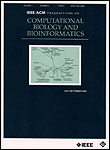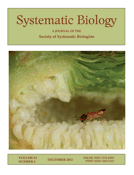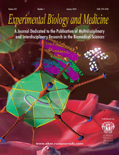
Quantitative Biology
Scope & Guideline
Integrating Data and Biology for Enhanced Understanding
Introduction
Aims and Scopes
- Mathematical Modeling and Simulation:
The journal emphasizes the development and application of mathematical models to simulate biological processes, including disease progression, genetic interactions, and cellular behaviors. - Bioinformatics and Computational Biology:
Research focusing on the use of computational tools and bioinformatics methods to analyze biological data, including genomic, proteomic, and metabolomic datasets. - Machine Learning and Artificial Intelligence in Biology:
The journal explores the application of machine learning algorithms in biological contexts, such as drug discovery, genomics, and predictive modeling of biological outcomes. - Systems Biology:
An integrative approach to understanding complex interactions within biological systems, including the modeling of cellular networks and organismal functions. - Synthetic Biology:
Research on the design and construction of new biological parts, devices, and systems, emphasizing quantitative approaches to understand and manipulate biological functions. - Clinical Applications and Translational Research:
The journal highlights studies that translate quantitative biological research into clinical applications, focusing on diagnostics, treatment strategies, and personalized medicine.
Trending and Emerging
- Integration of AI and Machine Learning:
There is a significant increase in research applying artificial intelligence and machine learning techniques to various biological problems, from drug discovery to genetic analysis. - Omics Data Integration:
Emerging studies focus on integrating multi-omics data (genomics, transcriptomics, proteomics) to provide a comprehensive view of biological systems and disease mechanisms. - Network Biology and Systems Analysis:
Research is increasingly centered around understanding biological networks, including gene regulatory networks and protein-protein interaction networks, using quantitative methods. - Personalized Medicine and Predictive Modeling:
The trend towards personalized medicine is reflected in studies that utilize predictive modeling to tailor treatments based on individual genetic profiles and clinical data. - Synthetic Biology Innovations:
There is a growing interest in innovative applications of synthetic biology, particularly in designing genetic circuits and metabolic pathways for therapeutic and industrial purposes.
Declining or Waning
- Traditional Statistical Methods:
There has been a decline in the use of conventional statistical approaches in favor of more advanced machine learning techniques and computational models. - Basic Life Sciences Research:
Research that primarily focuses on fundamental biological principles without quantitative analysis is becoming less prominent, as the journal leans more towards quantitative and computational studies. - Single-Cell Analysis Techniques:
Although still relevant, the frequency of publications specifically addressing single-cell analysis methodologies without a quantitative or computational focus has decreased. - Epidemiological Studies without Quantitative Models:
Studies examining public health issues and disease spread without employing quantitative modeling approaches are being published less frequently. - Genetic Studies with Limited Computational Analysis:
While genetic research remains a core area, there is a noticeable decline in studies that do not integrate computational techniques for data analysis.
Similar Journals

IEEE-ACM Transactions on Computational Biology and Bioinformatics
Catalyzing Progress in Applied Mathematics, Biotechnology, and GeneticsIEEE-ACM Transactions on Computational Biology and Bioinformatics is a prestigious journal published by the IEEE Computer Society, focusing on the interdisciplinary field of computational biology and bioinformatics. Established in 2004, this journal has made significant strides in contributing to our understanding of complex biological systems through quantitative methods and computational techniques, and it spans a converged publication period through 2024. As a notable resource with an impact factor that positions it in the second quartile in the domains of Applied Mathematics, Biotechnology, and Genetics, it serves as an essential platform for researchers and professionals seeking to disseminate their findings to a global audience. The journal ranks impressively in Scopus, with Applied Mathematics holding a rank of #38 out of 635 (94th percentile) and Genetics at #86 out of 347 (75th percentile), highlighting its significant influence in the scientific community. While the journal is not open-access, it provides valuable insights and cutting-edge research that are crucial for advancing the fields of bioinformatics and computational biology, making it indispensable for students, researchers, and practitioners alike.

JOURNAL OF COMPUTATIONAL BIOLOGY
Innovating Insights at the Intersection of Biology and TechnologyJOURNAL OF COMPUTATIONAL BIOLOGY, published by Mary Ann Liebert, Inc., serves as a premier platform for the dissemination of groundbreaking research at the intersection of biological sciences and computational methods. Established in 1994, this journal provides a valuable resource for researchers, professionals, and students interested in the evolving fields of computational mathematics and biology. With a commendable Q2 ranking in several pertinent categories such as Computational Mathematics and Modeling and Simulation, it emphasizes high-quality studies that propel understanding and innovation in these areas. Although the journal currently operates under traditional access options, it plays a crucial role in fostering scholarly communication and collaboration among a diverse audience, advancing knowledge in genetics, molecular biology, and beyond. The journal's continual evolution, with a commitment to publish until at least 2024, positions it as a critical resource in the fast-paced world of computational biology.

BIOESSAYS
Illuminating the Path of Biological ResearchBIOESSAYS, published by WILEY, is a leading academic journal dedicated to the dynamic fields of biochemistry, genetics, and molecular biology. With an impressive impact factor and recognized as a Q1 journal in its category for 2023, it ranks 49 out of 221 in the Scopus database, placing it within the 78th percentile among its peers. Since its inception in 1984, BIOESSAYS has served as a vital platform for researchers, professionals, and students, facilitating the dissemination of pivotal findings, innovative theories, and review articles that shape the current understanding of biological sciences. Although it does not offer open access, the journal remains key for those seeking to stay at the forefront of scientific discovery and discussion within this ever-evolving discipline. With its commitment to high-quality, peer-reviewed content, BIOESSAYS continues to influence future research directions and academic discourse.

Computational and Structural Biotechnology Journal
Fostering Discoveries at the Intersection of Technology and Life SciencesComputational and Structural Biotechnology Journal is a premier open-access journal published by Elsevier, focusing on the intersection of computer science and molecular biology. Since its inception in 2012, the journal has established itself as a leading platform for innovative research, featuring groundbreaking studies in biochemistry, biophysics, biotechnology, and genetics. With a remarkable Q1 ranking in multiple categories, including Biochemistry and Genetics, it stands out for its high impact, evidenced by its strong Scopus ranking percentile scores. As a vital resource for researchers, professionals, and students, the journal aims to foster the dissemination of essential findings that leverage computational techniques to explore complex biological systems. In a rapidly evolving scientific landscape, Computational and Structural Biotechnology Journal serves as an indispensable resource for those looking to contribute and stay abreast of major advancements in the field.

COMPUTERS IN BIOLOGY AND MEDICINE
Transforming Healthcare Through Cutting-Edge Computer ScienceCOMPUTERS IN BIOLOGY AND MEDICINE is a prestigious academic journal published by Pergamon-Elsevier Science Ltd, dedicated to advancing the fields of Computer Science Applications and Health Informatics. With an impressive impact factor and ranking within the Q1 quartile for both categories, this journal plays a crucial role in disseminating high-quality research findings that influence cutting-edge developments at the intersection of computing and healthcare. Covering a broad range of topics from computational biology to medical informatics, it serves as a vital resource for researchers, professionals, and students striving to harness technology for medical advancements. The journal has been publishing since 1970 and continues to evolve, incorporating the latest trends and innovations in the field, thereby ensuring that it remains a key contributor to scientific inquiry and knowledge. With accessible content and a global reach, COMPUTERS IN BIOLOGY AND MEDICINE invites submissions that elevate the understanding and application of computational methods in biological and medical contexts.

Systematic Biology
Championing innovative methodologies in biological research.Systematic Biology is a premier journal published by Oxford University Press, dedicated to advancing the field of systematic biology through rigorous research and comprehensive reviews. Established in 1952, this esteemed journal has become a cornerstone of scholarship in Ecology, Evolution, Behavior and Systematics and Genetics, consistently ranking in the Q1 category as of 2023. With an impressive Scopus ranking—19th in Ecology and Evolution and 23rd in Genetics—Systematic Biology offers a platform for the dissemination of groundbreaking research, novel methodologies, and critical discussions that shape our understanding of biological diversity and evolution. While the journal does not currently offer open access options, it maintains a strong commitment to quality and integrity in publishing, ensuring that every article contributes meaningfully to the scientific community. Researchers, professionals, and students alike will find valuable insights and a wealth of knowledge within its pages, supporting their work and fostering a deeper appreciation for the intricate web of life.

PLoS Computational Biology
Transforming Complex Data into Biological BreakthroughsPLoS Computational Biology is a premier open-access journal published by the Public Library of Science, committed to advancing the understanding of complex biological data through computational approaches. Since its inception in 2005, the journal has made significant strides in the fields of Cellular and Molecular Neuroscience, Computational Theory and Mathematics, Ecology, Genetics, and Molecular Biology, achieving a notable Q1 ranking in various categories as of 2023. With an exceptional impact factor and an esteemed ranking—such as Rank #23/176 in Computational Theory and Mathematics—PLoS Computational Biology provides a vital platform for researchers, professionals, and students to disseminate their cutting-edge findings and insights. The journal's open-access model ensures that high-quality research is freely accessible worldwide, fostering collaboration and innovation across disciplines. Located in San Francisco, CA, it serves as a hub for the global scientific community, making it an indispensable resource for anyone at the forefront of computational biology and its diverse applications.

EXPERIMENTAL BIOLOGY AND MEDICINE
Empowering researchers with open access to vital discoveries.EXPERIMENTAL BIOLOGY AND MEDICINE is a distinguished open-access journal published by FRONTIERS MEDIA SA, specializing in the interdisciplinary fields of biochemistry, genetics, and medicine. With an ISSN of 1535-3702 and an E-ISSN of 1535-3699, this journal presents a robust platform for cutting-edge research and innovative clinical studies. Since its inception in 1996, it has evolved to feature a broad scope that caters to the evolving needs of researchers, professionals, and students, ensuring a dynamic dissemination of knowledge in biological and medical sciences. In 2023, the journal achieved a notable Q2 ranking in both Biochemistry, Genetics and Molecular Biology and Medicine categories, reflecting its strong impact and relevance within the academic community, as supported by its Scopus rank of #59 out of 221 in general biochemistry and genetics, placing it in the 73rd percentile. By offering open access options, EXPERIMENTAL BIOLOGY AND MEDICINE aims to maximize the reach and visibility of research findings, fostering collaboration and knowledge sharing across global audiences. Researchers are encouraged to contribute to this vital resource as it continues to advance the understanding of biological mechanisms and therapeutic approaches crucial for modern medicine.

BIOSYSTEMS
Innovating the intersection of mathematics and life sciences.BIOSYSTEMS is a prestigious academic journal published by Elsevier Science Ltd, dedicated to the interdisciplinary fields of applied mathematics, biochemistry, genetics, molecular biology, medicine, modeling and simulation, and statistics and probability. Established in 1967, this journal has carved a niche in presenting innovative research that bridges theoretical and practical aspects of biological systems, making it essential reading for researchers, professionals, and students alike. With a robust impact factor and a Q3 category ranking across various fields, BIOSYSTEMS is recognized for its contributions to advancing scientific knowledge and fostering collaborations among disciplines. The journal's rigorous peer-review process ensures high-quality and impactful articles that address complex biological challenges through quantitative and qualitative methods. As a vital resource for the academic community, BIOSYSTEMS invites submissions that enhance understanding of biosystem processes, enabling readers to stay at the forefront of research trends and applications.

npj Systems Biology and Applications
Fostering Collaboration Across Biological Disciplinesnpj Systems Biology and Applications, published by NATURE PORTFOLIO, is a premier open-access journal that has been at the forefront of the field since its inception in 2015. With a commendable focus on the interdisciplinary integration of applied mathematics, biochemistry, computer science, and drug discovery, the journal currently enjoys a Q1 ranking across multiple categories, showcasing its significant impact within the scientific community. In 2023, it ranked 70 out of 635 in Applied Mathematics and holds a notable place in the 89th percentile, confirming its esteemed reputation among researchers. Situated in the United Kingdom, this journal not only promotes innovative research in systems biology but also serves as an essential platform for the dissemination of high-quality studies that delve into modeling, simulation, and the application of biological systems in drug discovery processes. With an open-access model, authors can reach a broad audience, enhancing collaborations and advancing knowledge across disciplines, making it an indispensable resource for researchers, professionals, and students alike seeking to contribute to the evolving landscape of systems biology.